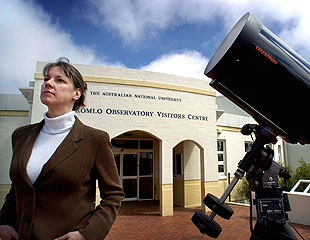|
|
|
|
|
|
|
News & Views item - May 2009 |
![]() The Astronomer and the Prime Minister. (May 27, 2009)
The Astronomer and the Prime Minister. (May 27, 2009)
 TFW
has pointed to the fact that despite the position of Australia's Chief Scientist
having been made fulltime by the Rudd government, up until the present its
occupier, ANU's Professor of Astronomy, Penny Sackett has been all but Das
Fräulein ohne Schatten.
TFW
has pointed to the fact that despite the position of Australia's Chief Scientist
having been made fulltime by the Rudd government, up until the present its
occupier, ANU's Professor of Astronomy, Penny Sackett has been all but Das
Fräulein ohne Schatten.
Now an article by Jill Rowbotham in the Higher Education Supplement of today's Australian essentially promises us that this is about to change: "She has sound reasons to expect the "menu" of challenges served up by the council's standing committee will be well received by the Prime Minister, his Innovation, Industry, Science and Research Minister Kim Carr and 10 other federal ministers at the coming meeting of the Prime Minister's Science, Engineering and Innovation Council (PMSEIC).
According to the PSEIC website the Standing Committee meets "four times a year. Much of its work is undertaken through working groups comprising members and those co-opted from industry, universities, science agencies and government departments. The Standing Committee responds to issues referred by Government or by meetings of PMSEIC; and identifies and develops a range of issues to be considered by PMSEIC.
Currently the standing committee consists of:
Professor Graeme Turner, Director, Centre for Critical and Cultural Studies, University of Queensland
In a white paper released with the budget notes that PMSEIC is establishing formal structures to "look over the horizon and provide the strategic foresight needed to support long-term, whole-of-government policy development," and that Professor Sackett will chair the co-ordination group that will implement the new Australian Climate Change Science Framework, charged with setting national priorities in climate change science for the next decade.
Just what's going to ensue could be interesting in view of Professor Sackett's address to FASTS during Science Meets Parliament.
According to Ms Rowbotham, under Professor Sackett's direction the standing committee will present ideas to the prime minister and council first, to gauge their priorities: "Having presented some broad ideas, some conversation starters ... we want to engage in consultation regarding the foresighting process with the Prime Minister and ministers."
While Professor Sackett won't reveal the themes the "standing committee and its four 'foresighting clusters' have identified" she agrees "It would be odd if [the issue of climate change] did not."
Ms Rowbotham summarises Professor Sackett's intended methodology: "Applying a consultative approach is one of three criteria according to which ideas must be managed. 'Also, they must always be addressed with a long-term outlook.' While there will always be exceptions, things that need a quick turnaround, the approach must be overwhelmingly far-sighted. 'We almost want our nearest horizon to be five years.' Finally, there must be a cross-portfolio commitment to the investigations, to maximise expertise. 'It's where most value can be added... the need is to imagine the future', to ask the question: 'In the next 10 to 50 years, what problems might Australia face? And then we do a stocktake of where we are now and draw a line, including the challenges and opportunities that might intersect that line. We want to identify the gaps in our knowledge and try to fill them. What we are about is, that if the ship needs to be turned, that we (should be) signalling the need to do it long before it becomes critical.' All the detailed reports will be available on the PMSEIC website once the Prime Minister has read them. 'We also want to be able to make a summary for people who do not want to invest that much time.'"
In light of what appear to be the views of a very emphatic Chief Scientist, and one who has now emphasised there must be a cross-portfolio commitment to the investigations, to maximise expertise, the Office of Chief Scientist must be transferred to the Department of Prime Minister and Cabinet without further delay, in which case she will have gained a distinct shadow.